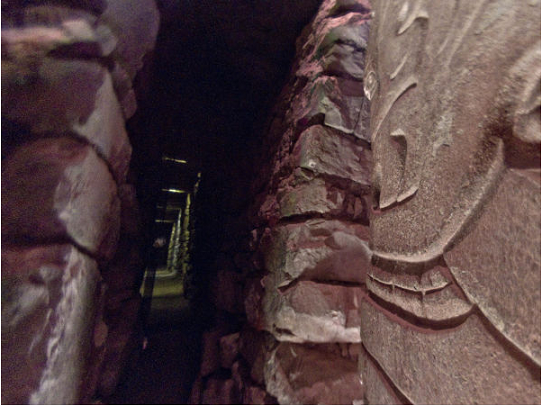
Vancouver - More than three millennia ago, ancient people flocked to Chavín de Huantar, a village in a high valley in the Peruvian Andes, to hear the oracles speak. And indeed they spoke - in the voice of resonant conch shell trumpets, and with the help of some clever architectural design, according to findings presented here today at the annual meeting of the American Association for the Advancement of Science (which publishes ScienceNOW). The research suggests that the Chavín culture - and perhaps other ancient cultures - knew acoustic tricks that might be the envy of a modern concert hall engineer.
Chavín de Huantar consists of terraces, squares, ornate megaliths, and a temple, and there's abundant evidence that it was used for religious ceremonies. The site also contains bas-relief sculptures sporting powerful animal imagery, including jaguars, condors, and snakes; images of hallucinogenic plants; and artifacts of the tools used to prepare them for consumption.
Chavín de Huantar is particularly well suited to the study of ancient uses of sound, says Miriam Kolar, an archeoacoustics researcher at Stanford University. That's because the interior architecture contains elaborate, multilevel mazes with long corridors and staircases that affect acoustics today and are well enough preserved to detect what the original residents must have heard. What's more, ancient conch shell trumpets have been excavated in the village; when blown into, the shells make a haunting, warbling sound, and fossil conch shells are embedded in stones on the floor of the temple. Kolar played a recording of the conch shell trumpet at the meeting. "It's not very imposing over loudspeakers," she said. "But in person it rattles your bones."
In the 1970s, a Peruvian archeologist had identified a large canal at Chavín de Huantar with built-in terraces, which he proposed were built to create sound from water rushing over edge. Kolar and her colleagues suspected that other parts of the site might have been designed and built to create certain sound effects. Sure enough, a long, narrow central passageway grew narrower, a design that ensured that the sound of conch shell trumpets called pututus, but not other sounds, propagates from the interior passages of the temple to the outside. The researchers suspect that a priest would call to the oracle in full view of the assembled crowd, and the haunting sound of a pututu would emerge, thanks to someone playing the conch shell instrument inside the structure. Indeed, in acoustical terms, the corridors serve as so-called wave guides, which guide sound waves farther than they'd otherwise travel, Kolar said.
To test the idea that the builders of the temple had a sophisticated understanding of acoustics, Kolar and her colleagues placed archeological staff - professors, graduate students, or their Peruvian colleagues - at different locations in the narrow, mazelike passageways inside the temple, played sounds from loudspeakers located at various points in the maze, and asked the volunteers where the sound was coming from. The design of the maze misled people about the true location of the sound source, which may have added to the numinous atmosphere the builders intended. These results added more evidence that the ceremonial center at Chauvin de Huantar was designed with acoustics in mind.
"She has good evidence to show that [the acoustic design] was purposefully done, says Steven Waller, an independent scholar in La Mesa, California, who has investigated the acoustics of ancient ceremonial caves, and who presented evidence at the session showing that Stonehenge and other stone circles in the British Isles were designed with acoustics in mind. What the results do, he adds, "is show that all archeological sites have the potential for acoustic effects, so we should preserve soundscapes of these sites in case they're important."
The haunting sound of Chavín conch shell trumpets here.



Reader Comments
to our Newsletter